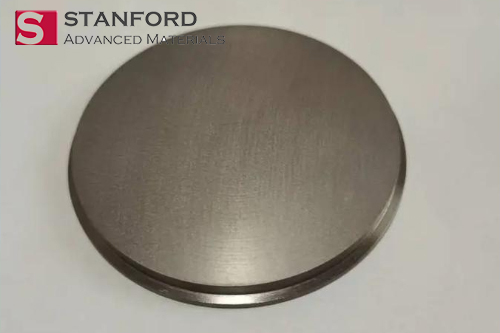1. Introduction
Sputtering targets play a central role in physical vapor deposition (PVD) processes, forming the thin functional layers found in semiconductors, optical components, solar panels, and wear-resistant coatings. As industries continue to push for better film quality, consistency, and performance, the demand for advanced sputtering targets grows accordingly.
In particular, refractory metals such as tungsten (W), molybdenum (Mo), and niobium (Nb) are widely used for their high melting points, mechanical strength, and chemical stability. However, these same properties also make them difficult to process using conventional melting or machining techniques.
That’s where powder metallurgy (PM) becomes essential. As a solid-state fabrication technique, PM offers better control over microstructure, composition, and density—key factors in determining a target’s performance in sputtering environments. This article explores how powder metallurgy is applied to sputtering target manufacturing and why it has become the preferred route for many high-end applications.
2. What Makes a Sputtering Target Work?
At first glance, a sputtering target seems simple—a disc or cylinder of metal bonded to a backing plate, usually copper. But the underlying performance relies on several critical parameters, each influencing the stability and efficiency of thin film deposition.

Key Performance Criteria:
-
Purity (≥99.9%): Impurities can alter film properties or introduce defects, especially in sensitive electronic applications.
-
High Density, Low Porosity: Reduces gas trapping and improves sputtering yield. Denser targets also last longer and produce more uniform films.
-
Consistent Grain Size and Texture: Ensures even erosion during sputtering and better control over film growth.
-
Mechanical Strength: Minimizes the risk of cracking or delamination during thermal cycling or high-power operation.
Targets that meet these criteria enable stable plasma, consistent deposition rates, and high-quality films with fewer defects.
3. Powder Metallurgy: Step-by-Step
Powder metallurgy offers a route to produce targets with tight control over structure and composition. Here’s how the process works in practice.
3.1 Powder Preparation
Everything starts with metal powders. These are typically produced through atomization, where molten metal is broken into fine droplets, or chemical reduction methods for higher purity. For composite targets like ITO (indium tin oxide) or ZTO (zinc tin oxide), powders must be pre-blended or even pre-reacted to ensure homogeneity.
3.2 Ball Milling & Spray Granulation
Next, the powders undergo ball milling. This step reduces agglomerates, refines particle size, and enhances reactivity. In many cases, nanostructured powders improve sintering behavior and end-product density. Spray granulation follows to convert fine powders into spherical granules—these flow better and compact more uniformly during pressing.
3.3 Compact Forming
Powders are shaped into green bodies using uniaxial pressing or cold isostatic pressing (CIP). While uniaxial pressing is simpler, CIP is preferred for critical applications—it applies pressure from all directions, resulting in uniform density and fewer defects.
3.4 Sintering
The green compact is then sintered in a controlled atmosphere, usually inert gases or low-oxygen environments. The temperature varies by material—often above 650°C, and much higher for refractory metals. Hot pressing or pressure-assisted sintering may be used to improve density and dimensional accuracy.
3.5 Post-Processing
Once sintered, the target undergoes several finishing steps:
-
Debinding to remove organic residues.
-
Surface Grinding and Polishing to achieve tight dimensional tolerances and surface flatness.
-
Bonding to Backing Plate via soldering, diffusion bonding, or vacuum brazing, ensuring good thermal and electrical contact during use.
4. How Powder Metallurgy Enhances Performance
PM methods directly influence the functional performance of the final sputtering target:
-
Higher Density: Near-full density improves sputter rates, reduces arcing, and extends service life.
-
Controlled Microstructure: Uniform grain size improves erosion behavior and reduces variability during deposition.
-
Purity Assurance: Clean processing environments and powder selection help minimize contamination—critical for microelectronics and optoelectronics.
-
Improved Toughness: Proper processing reduces internal stress and brittleness, lowering the risk of cracking under thermal or mechanical stress.
For demanding applications like advanced chips, OLEDs, or hard coatings, these advantages translate into better yield, longer equipment life, and more consistent product performance.
5. Special Considerations for Refractory Metals
Refractory metals bring both opportunity and challenge. Their high melting points—up to 3,400°C for tungsten—make conventional casting impractical. Even in PM, sintering requires careful control.
Challenges Include:
-
Sintering Behavior: Achieving full densification at very high temperatures without causing grain growth or distortion.
-
Forming Limitations: These metals are brittle at room temperature, requiring gentle, uniform compaction techniques.
-
Phase Stability: High sintering temperatures may cause phase transformations or oxidation. Process gases and heating rates must be tightly managed.
-
Surface Sensitivity: Oxide layers or contamination during processing can affect bonding or film adhesion.
For these reasons, every stage from powder design to final bonding must be carefully engineered.
6. Conclusion
Powder metallurgy has become an indispensable method for producing high-performance sputtering targets—especially for refractory metals and complex composites. Its ability to deliver dense, pure, and mechanically robust targets directly supports the needs of advanced thin film deposition in electronics, optics, energy, and more.
The success of PM-based targets depends not only on the materials used, but on precise control throughout the process—from powder quality to sintering conditions to bonding techniques. As demand for high-efficiency PVD processes continues to grow, powder metallurgy will remain at the core of innovation in sputtering target manufacturing.
At Stanford Advanced Materials, we offer a wide range of refractory and compound sputtering targets tailored through precision powder metallurgy. Whether you’re building a next-gen semiconductor or scaling up optical coating, we can help you source the right target—engineered for performance, delivered with confidence.





